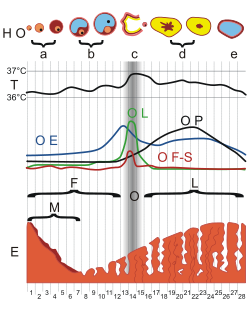Dysmenorrhea

Editor-In-Chief: Prab R Tumpati, MD
Obesity, Sleep & Internal medicine
Founder, WikiMD Wellnesspedia &
W8MD medical weight loss NYC and sleep center NYC
| Dysmenorrhea | |
|---|---|

| |
| Synonyms | Menstrual cramps |
| Pronounce | N/A |
| Specialty | N/A |
| Symptoms | Pelvic pain, lower back pain, nausea, vomiting, diarrhea, headache |
| Complications | N/A |
| Onset | Menarche |
| Duration | 1–3 days per menstrual cycle |
| Types | Primary dysmenorrhea, Secondary dysmenorrhea |
| Causes | Prostaglandin release, endometriosis, uterine fibroids, adenomyosis, pelvic inflammatory disease |
| Risks | Early menarche, heavy menstrual bleeding, nulliparity, smoking |
| Diagnosis | Based on symptoms and medical history |
| Differential diagnosis | Ectopic pregnancy, ovarian cyst, pelvic inflammatory disease |
| Prevention | Hormonal birth control, NSAIDs |
| Treatment | NSAIDs, hormonal birth control, heat therapy, exercise |
| Medication | Ibuprofen, naproxen, oral contraceptive pill |
| Prognosis | N/A |
| Frequency | Common, affects up to 90% of adolescent females |
| Deaths | N/A |
Dysmenorrhea is a medical term for painful menstruation, which interferes with daily activities. The severity of pain can range from mild to severe and is often accompanied by other symptoms such as nausea, vomiting, fatigue, and even diarrhea.
Types[edit]
- There are two types of dysmenorrhea: primary and secondary.
- Primary dysmenorrhea is menstrual pain not associated with any specific pelvic pathology. It often starts a few years after a girl starts menstruating, when ovulation begins.
- Secondary dysmenorrhea is menstrual pain that's attributed to an identifiable medical problem, such as endometriosis or uterine fibroids.
Symptoms[edit]
The primary symptom of dysmenorrhea is pain concentrated in the lower abdomen, in the umbilical region, or the suprapubic region. It can be accompanied by other symptoms, such as nausea, vomiting, fatigue, and diarrhea.
Treatment[edit]
Treatments for dysmenorrhea range from over-the-counter medication and lifestyle changes, such as improved diet and regular exercise, to prescription drugs and, in severe cases, surgery. Nonsteroidal anti-inflammatory drugs (NSAIDs) are the primary over-the-counter medication used to relieve menstrual cramps.
Prevention[edit]
While not all cases of dysmenorrhea can be prevented, maintaining a healthy lifestyle including regular exercise and a balanced diet can help reduce symptoms. The use of a heating pad on the lower abdomen may also provide some relief.
See Also[edit]
References[edit]
- "Dysmenorrhea". Mayo Clinic.
- "Dysmenorrhea". Johns Hopkins Medicine.
- "Dysmenorrhea". American College of Obstetricians and Gynecologists.
External Links[edit]
Dysmenorrhea - MedlinePlus Dysmenorrhea - American College of Obstetricians and Gynecologists
Ad. Transform your life with W8MD's Budget GLP-1 injections from $75


W8MD offers a medical weight loss program to lose weight in Philadelphia. Our physician-supervised medical weight loss provides:
- Weight loss injections in NYC (generic and brand names):
- Zepbound / Mounjaro, Wegovy / Ozempic, Saxenda
- Most insurances accepted or discounted self-pay rates. We will obtain insurance prior authorizations if needed.
- Generic GLP1 weight loss injections from $75 for the starting dose.
- Also offer prescription weight loss medications including Phentermine, Qsymia, Diethylpropion, Contrave etc.
NYC weight loss doctor appointmentsNYC weight loss doctor appointments
Start your NYC weight loss journey today at our NYC medical weight loss and Philadelphia medical weight loss clinics.
- Call 718-946-5500 to lose weight in NYC or for medical weight loss in Philadelphia 215-676-2334.
- Tags:NYC medical weight loss, Philadelphia lose weight Zepbound NYC, Budget GLP1 weight loss injections, Wegovy Philadelphia, Wegovy NYC, Philadelphia medical weight loss, Brookly weight loss and Wegovy NYC
|
WikiMD's Wellness Encyclopedia |
| Let Food Be Thy Medicine Medicine Thy Food - Hippocrates |
Medical Disclaimer: WikiMD is not a substitute for professional medical advice. The information on WikiMD is provided as an information resource only, may be incorrect, outdated or misleading, and is not to be used or relied on for any diagnostic or treatment purposes. Please consult your health care provider before making any healthcare decisions or for guidance about a specific medical condition. WikiMD expressly disclaims responsibility, and shall have no liability, for any damages, loss, injury, or liability whatsoever suffered as a result of your reliance on the information contained in this site. By visiting this site you agree to the foregoing terms and conditions, which may from time to time be changed or supplemented by WikiMD. If you do not agree to the foregoing terms and conditions, you should not enter or use this site. See full disclaimer.
Credits:Most images are courtesy of Wikimedia commons, and templates, categories Wikipedia, licensed under CC BY SA or similar.
Translate this page: - East Asian
中文,
日本,
한국어,
South Asian
हिन्दी,
தமிழ்,
తెలుగు,
Urdu,
ಕನ್ನಡ,
Southeast Asian
Indonesian,
Vietnamese,
Thai,
မြန်မာဘာသာ,
বাংলা
European
español,
Deutsch,
français,
Greek,
português do Brasil,
polski,
română,
русский,
Nederlands,
norsk,
svenska,
suomi,
Italian
Middle Eastern & African
عربى,
Turkish,
Persian,
Hebrew,
Afrikaans,
isiZulu,
Kiswahili,
Other
Bulgarian,
Hungarian,
Czech,
Swedish,
മലയാളം,
मराठी,
ਪੰਜਾਬੀ,
ગુજરાતી,
Portuguese,
Ukrainian


